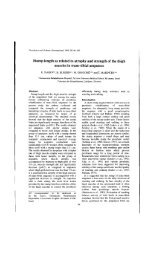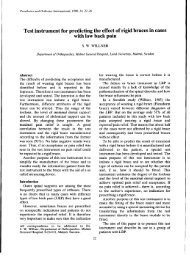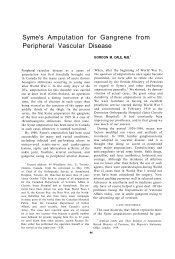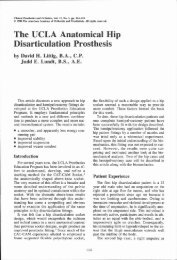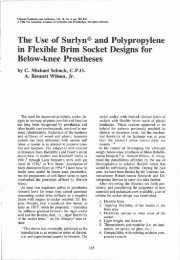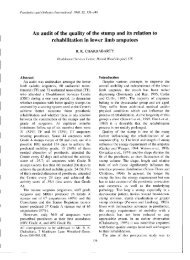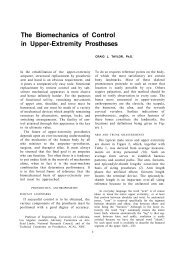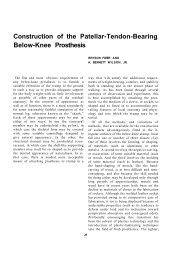Pro-Corn - O&P Library
Pro-Corn - O&P Library
Pro-Corn - O&P Library
Create successful ePaper yourself
Turn your PDF publications into a flip-book with our unique Google optimized e-Paper software.
Figure 3C. Typical forefoot deformities of rheumatoid<br />
arthritis—hallux valgus and dorsal dislocation<br />
of metatarsalphalangeal joints (plantar<br />
view).<br />
Figure 3D. Typical forefoot deformities of rheumatoid<br />
arthritis—hallux valgus and dorsal dislocation<br />
of metatarsalphalangeal joints (lateral<br />
view).<br />
physical exam by watching the patient in a<br />
standing position. In addition to the elevated<br />
longitudinal arch, heel varus may be noted.<br />
Plantar flexion of the first ray may be present<br />
and can be seen by viewing the foot anteriorly<br />
with the patient seated. Stabilize the calcaneus<br />
in alignment with the tibia and note the level of<br />
the plantar aspect of the first metatarsal head<br />
relative to the others. The patient with metatarsalgia<br />
secondary to pes cavus may benefit from<br />
a soft arch support to increase the weight<br />
bearing surface of the foot and to improve<br />
shock attenuation.<br />
Ankle Instability<br />
Ankle instability may be the result of lateral<br />
ligamentous laxity, a varus heel, or a varus angulated<br />
tibia. 4<br />
A patient with lateral ligamentous<br />
laxity of the ankle may give a history of<br />
having initially sustained an ankle sprain secondary<br />
to significant ankle trauma followed by<br />
recurrent sprains with minimal or no trauma.<br />
The wearing of high heeled shoes worsens the<br />
tendency of recurrent ankle sprains as this further<br />
throws the foot into supination.<br />
Ligamentous laxity causing ankle instability<br />
can usually be demonstrated by the "lateral<br />
talar tilt" test. The ankle is stress tested both in<br />
dorsiflexion, to test the calcaneofibular ligament,<br />
and in plantarflexion, to test the anterior<br />
talofibular ligament. The tibia is held stationary<br />
as the examiner applies pressure on the lateral<br />
aspect of the hindfoot in a medial direction<br />
(Figure 4). The ankle, which lacks adequate<br />
ligamentous support, will tilt medially indicating<br />
instability.<br />
The presence of heel varus can be appreciated<br />
by viewing the patient from behind as he<br />
stands with shoes removed. It will be noted that<br />
the calcaneous is medial to the longitudinal axis<br />
of the tibia. Upon manipulation of subtalar<br />
joint motion, there may be decreased eversion<br />
of the calcaneous relative to inversion.<br />
A person who had a varus angulated tibia,<br />
either from a congenital deformity or secondary<br />
to a tibia fracture which has united in varus,<br />
may also experience ankle instability. With<br />
such malalignment, the biomechanical forces<br />
pass lateral to the center of the calcaneous. Observing<br />
the standing patient from the front, the<br />
examiner will note that an imaginary plumb<br />
line dropped from the center of the patella will<br />
fall lateral to the center of the ankle on the affected<br />
side.<br />
A lateral heel and sole wedge tilts the hindfoot<br />
into slight valgus to help prevent recurrent<br />
ankle instability.



